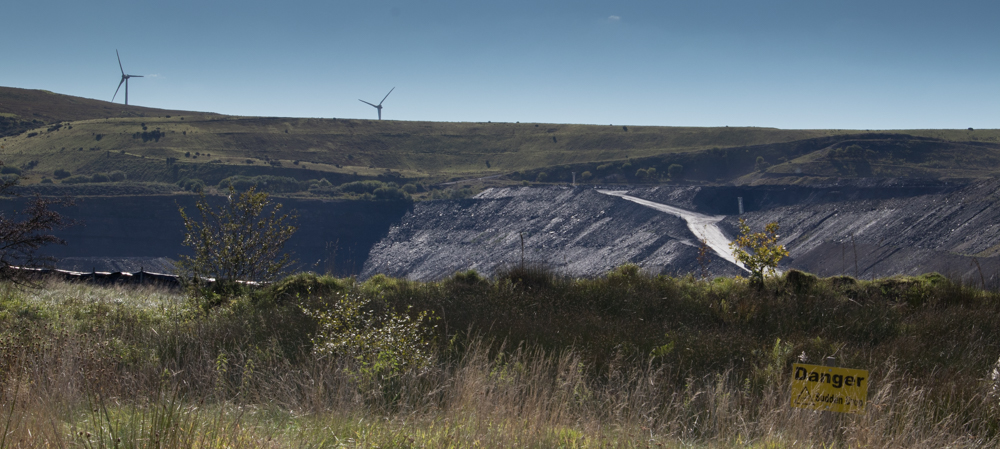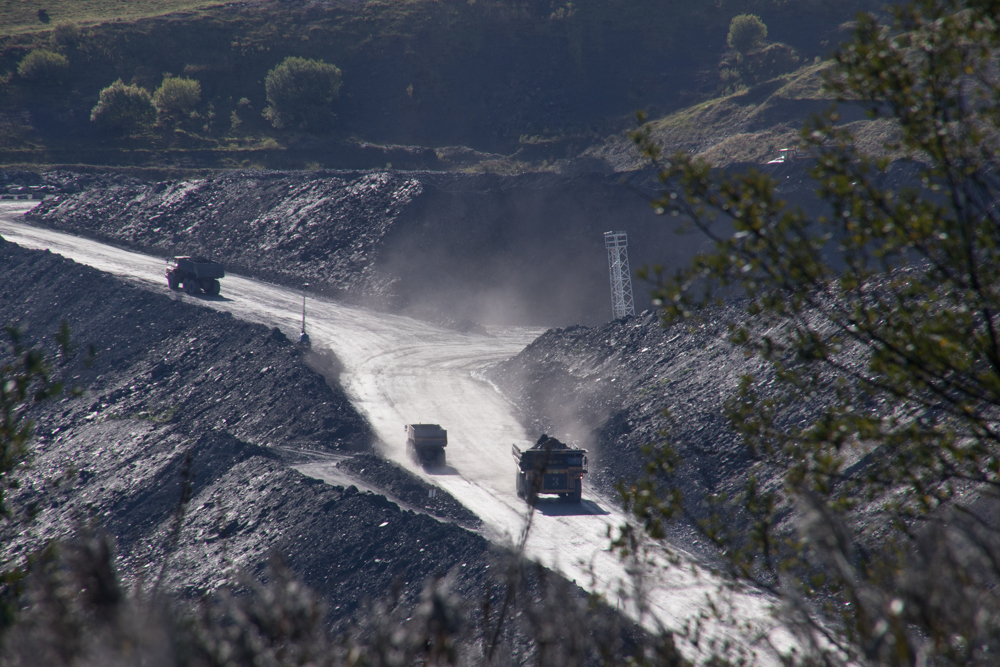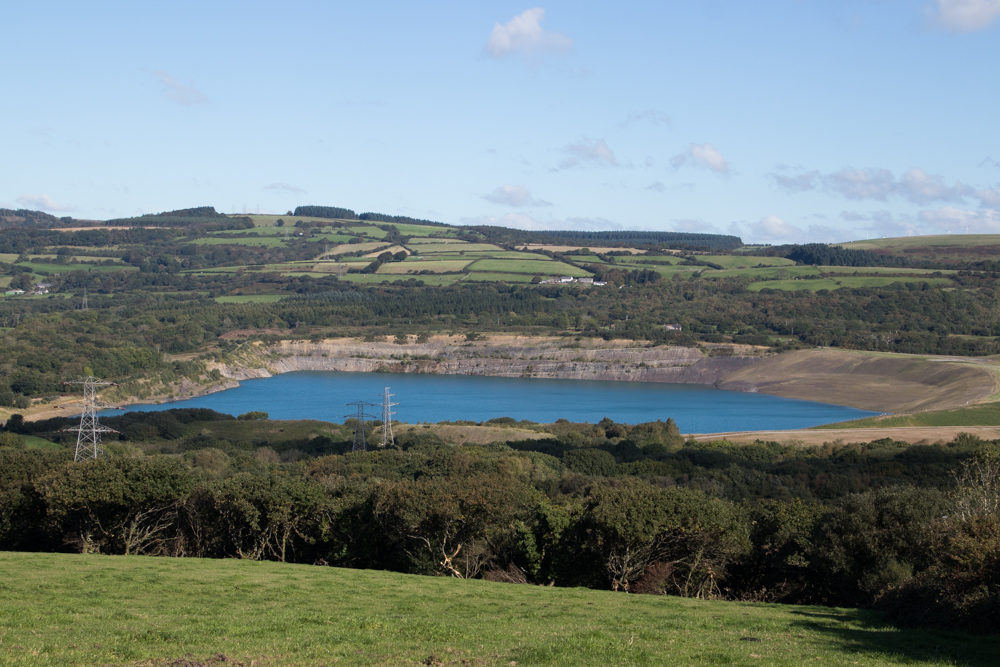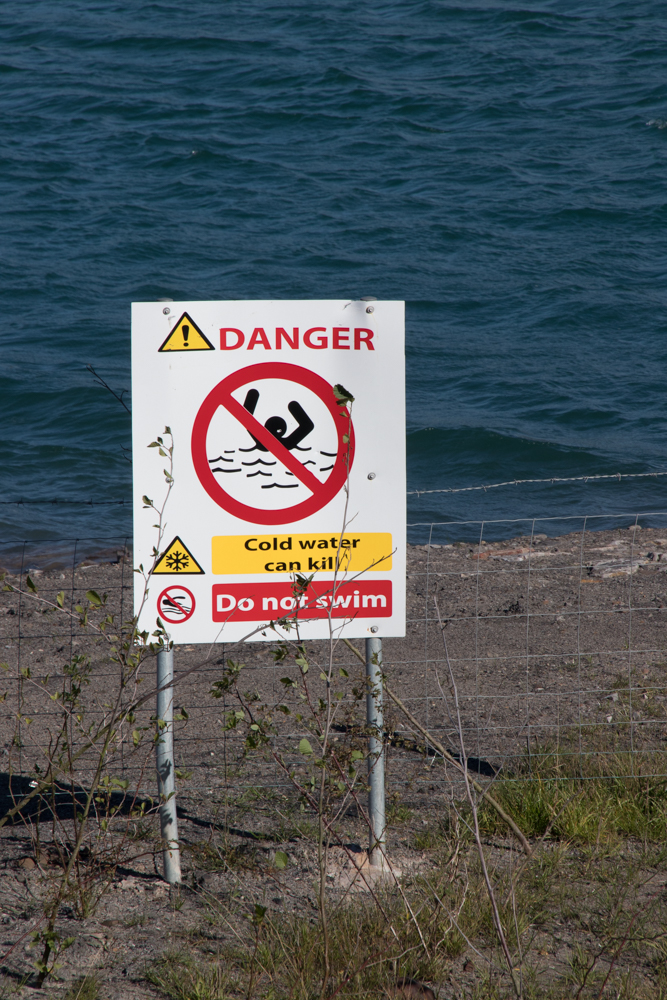Eddy Blanche is jubilant. “I still can’t believe we won – it took us five years but we beat them. I’m gobsmacked.”
The rejection of the extension to the Ffos-y-Fran mine at the top of the Rhymney Valley in Wales has been seen by campaigners as an historic victory. Known as Nant Llesg, the new section of mine would have seen the extraction of another six million tonnes of coal from the site, which has been in operation since 2007.
Caerphilly County Borough Council turned down the application in 2015. The developer, then known as Miller Argent, lodged an appeal. But the Planning Inspectorate threw out the case in September after the company, by then known as Blackstone (Merthyr Limited), failed to submit extra information on the environmental statement it had requested.
“It wasn’t just a win for us, it was a win for all campaigns — against fracking, open cast mines, street trees being cut down,” Blanche, a committee member of campaign group United Valley Action Group (UVAG) enthuses.
The win is a double-edged sword for the local community, however. Many fear that the loss of income from the new mine will mean that the hole in the ground at Ffos-y-Fran — which is over 150m deep in places — will never be filled in, and the site restored.”
“They’ve always come up with the argument that Nant Llesg will pay for the restoration of Ffos-y-Fran. Without Nant Llesg they’re dead in the water. They’ve got another five years of coaling left, then they get a big bill.”
“I do not see the site being restored. Once they’ve had all the profit, who’s going to spend it filling a hole back in, it doesn’t make business sense,” Blanche says.
Recent history suggests Blanche has good reason to be concerned.
Legal Action
Ffos-y-Fran was given the green light in 2005. The planning permission stated that coal extraction at the 400 hectare site should end by 6 September 2022, and Miller Argent signed a Section 106 agreement committing to restore the site by 6 December 2024.
The mining company touts the coal extraction as part of a land reclamation scheme. According to its website, the scheme “will create a better and safer environment for the local community for the benefit of future generations. We will also ensure that the site is sensitively restored to encourage local biodiversity, by creating a range of different habitats for wildlife.”
However, in 2014, Miller Argent’s parent companies decided to get out of the coal mining business.
The guarantee that had been set up in 2007 to cover the restoration of the site was replaced by an escrow account, under which Blackstone — a subsidiary of Miller Group and Argent Group — agreed with Merthyr Tydfil County Borough Council to pay for the restoration of the land. Provision was made for the mining company to make quarterly deposits into the account, which would total £15 million by the time mining operations ended.
But to date the mine operator has not deposited any funds into the account.
The council took it to court earlier this year, claiming that it was in default of payments totalling £5 million, with a further £625,000 due at the end of June.
Miller Argent — which according to filings at Companies House has changed name twice this year, to Blackstone (Ffos-y-Fran) Ltd, and then to Blackstone (Merthyr) Ltd — claimed that it was not obliged to make the regular deposits, and that its only obligation was to ensure that the money was in the account by 30 June 2022.
The court found in the council’s favour, and ordered Blackstone to make both the payments that it had missed, and the payment due at the end of June. However, in September, the council revealed that the company was seeking leave to appeal the ruling.
The ongoing legal action is casting a shadow over local communities, according to Dawn Bowden, Welsh Assembly Member for Merthyr Tydfil and Rhymney. Despite the relief felt by many over the rejection of the Nant Llesg mine, people “were watching with growing concern the seemingly endless litigation” around Ffos-y-Fran, she says.
“The arguments over that current, and ongoing, opencast site is not building faith in the industry in spite of the employment opportunities that come with such an operation,” she says.
Chris Austin, Secretary of UVAG, said the community was now facing the possibility that the site would not be restored. “The community has had to suffer the awful impact of the mining operation for the last ten years with the only ‘carrot’ being that ‘it will be lovely when it’s finished’.”
“Not only that, the restoration work that has been carried out is to a poor standard and not the public amenity that was promised. The company is working for straight profit and hasn’t paid a penny into the restoration fund,” he adds.
People were “incensed”, but had been met with a ‘there’s nothing you can do about it’ response, he says.
The court case win was a Pyrrhic victory, Austin believes. “If the council attempt to seize the mining company’s assets, they’ll find that the company has secured them across several other companies and will threaten to go bust rather than hand anything over,” he says.
The council would then be left with nothing, 100 people would be made redundant and the mine would still be unrestored, he says. The local authority is not discussing the situation with UVAG, or local councillors, which could mean that they are “horse trading” with the mining company, Austin believes.
A spokeswoman for Merthyr Tydfil County Borough Council said the authority was unable to comment due to ongoing legal proceedings. Merthyr South Wales did not respond to a request for comment for this article.
Broken Promises
Whatever the eventual result of the litigation, the £15 million is thought to be a significant underestimate of the cost of restoring the mine. An official report for the Welsh Government in 2014 estimated the final “worst case restoration cost” of the site at over £50 million, based solely on how much it would cost to move the earth from “very large” overburden mounds back into the void of the mine, and treatment of the surface of the 400ha site.
The research, carried out by environmental consultants ERM, investigated inadequate restoration of all unrestored coal sites in South Wales. The government wanted to know what the current and potential risks were if one of the mining companies was to fail, or abandon the site, and also the reasons why sites might not be restored.
It flagged Ffos-y-Fran as being at risk of not being restored due to having insufficient bond cover, along with Tower in Rhondda Cynon Taf, Nant Helent, in Powys, and East Pit and Margam in Neath Port Talbot. A site at Dynant Fawr in Carmarthenshire has effectively been abandoned unrestored, it stated.
The 400 hectare East Pit mine has seen open cast coal mining since 1980, originally under the National Coal Board, and then by mining operator Celtic Energy. Various extensions to the mine have been made over the years, but in 2004, a restoration plan was agreed as part of a planning application for a further extension. This would have seen the hole left by mining filled back in and the land returned to its former state, and would have cost up to £100 million, according to the Welsh Government report.
But in 2012, Celtic Energy proposed new plans for the site’s restoration, including a country park and leisure resort, with a 120-bed hotel and 78 holiday lodges. The void left by the mine would be filled with water to become a recreational lake, with a diving centre.
After years of hearing promises that the site would be restored to its former state, the new plan did not go down well with the local community, says Arwyn Woolcock, Labour Councillor on Neath Port Talbot County Borough Council. “It’s left a very bitter taste in the mouths of the people,” he says.
Objections from local people documented in the Planning Officer’s report reveal the extent of distrust felt against Celtic Energy.
They said the planned lake was just a way of avoiding the previously promised restoration, it was a “sham” that would allow the mining company to walk away from the site if it proved commercially unviable, and that it was a “disaster waiting to happen”, referring to the perceived danger from the old mine being filled with water.
Also in the planning report, Celtic Energy said that the plan for the lake and resort was the only realistic option for restoring the site, and that it represented “the best possible compromise between what is achievable and what is publicly acceptable”.
If the plan was not approved, or if it was referred to the Welsh Government, operations at the site would become unviable and 70 employees would have to be made redundant “almost immediately” it stated.
Legacy
The lake and leisure developments were approved by the Council in 2015.
Will Watson, Chief Executive of Celtic Energy, admits that the original restoration plan, agreed in 2004, could not be taken forward as it was too expensive. However, he explains that over the years, the mining company has refocused its restoration efforts, away from restoring common land and towards leaving a legacy of affordable housing and employment.
Since it received outline planning permission for the lake and resort in 2015, the company has identified a site for housing on the land, which will incorporate a combination of private homes, housing for rent through a housing association, and self-build plots where residents will be able to have workshops next to their homes to enable small businesses to get off the ground, he says. Homes would have solar panels and ground-source heat pumps, he adds.
Celtic Energy is currently looking for a developer to take the scheme forward to planning application.
“The restoration at East Pit is fully funded. The position that Celtic Energy found itself in was due to the way the UK government privatised the industry. But that’s history”, he says.
“We’re very comfortable with our relationship with the Welsh Government and the local authorities. We’re happy with the restoration schemes that have been approved, and that we’re going to complete those properly and everything is going to be fine.”
The company was focused on helping the communities move forward, and the restoration plans were fully discussed with the public at the time of the planning application, he adds.
“Over the years, we’ve built a race track on one of our restored sites, a golf course on another, we’re building a country park at East Pit and we want to build a rail centre of excellence at Nant Helen.”
“We’re very much about doing what we can to leave a legacy in the areas post-coaling,” he says.
Track Record
The company’s actions at another mine in the area have left a legacy of distrust, however.
The 200 hectare mine at Margam ceased operations in 2008. Celtic Energy ran the mine, but in 2010 transferred the land ownership of Margam and three other sites to Beech Regeneration, a subsidiary of Oak Regeneration, which is based in the British Virgin Islands. The price for each site was £1.
The transfer was investigated by the Serious Fraud Office in 2014, who alleged that six employees of Celtic Energy, including two former directors, conspired to defraud Neath Port Talbot County Borough Council, Bridgend County Borough Council, Powys County Council and the Coal Authority by deliberately preventing them from enforcing obligations to restore the sites.
Legal proceedings failed. Celtic Energy claimed it had no funds for the restoration, which was now the legal responsibility of Oak Regeneration. In his ruling, Mr Justice Hickinbottom, said that although the behaviour of the company was “morally reprehensible”, it was not illegal.
At the time, Neath Port Talbot Council held a bond of £5 million to restore Margam, but estimated that the restoration would cost around £56 million. The council, together with neighbouring Bridgend County Borough Council, conservation body Natural Resources Wales and the Coal Authority, has now used this bond money to pay for a cheaper restoration scheme, which will see the site reopened to the public.
But it remains a huge scar in its landscape. The void of the mine is still full of water, which at 108m is the deepest lake in England and Wales. A fence surrounding the lake displays signs warning of “Danger” and “Beware, deep water”. Households facing towards the site have grown trees high to block the view from their everyday lives.
Isobel Tarr, campaigner with the Coal Action Network, says that the site restoration carried out by the council is inadequate. “The amount that they’ve spent is a fraction of what would have been spent if the company had paid up.”
“The original agreement was that everything got put back in the hole and re-landscaped with habitats restored – what the council has settled for is that it gets dressed up a place for people to ‘enjoy’ even though there are ‘danger’ signs everywhere,” she says.
“The story remains the same – companies can get away with leaving a dangerous mess if they move their assets offshore, then it’s up to the council to make the best of it with a fraction of the money,” she adds.
One of the causes of the lack of restoration of mine sites identified by the Welsh Government report, including at Margam, was the change in land ownership.
This trend is something the community at Ffos-y-Fran has long been aware of. “One of our fears has always been, as has happened in other places, that the original company has sold the mine on as it has progressed towards the end of its life. But we were told by the council that it wouldn’t be a problem,” says Blanche.
Scotland has seen similar problems.
In 2013, two open cast coal mining companies Scottish Coal and Aardvark TMC, went into liquidation. Six open cast sites were left unrestored by the companies, including Powharnel in East Ayrshire, located on a site whose importance to nature was designated by EU law as a Special Protection Area (SPA). The scale of environmental degradation left behind at this site was particularly bad, with an independent report describing it as “difficult to comprehend”.
A complaint was made to the European Commission about the damage to the SPA caused by the abandoned mine workings, forcing the Scottish Government to get involved. It set up a charity, the Scottish Mines Restoration Trust (SMRT) to restore six derelict mines, including Powharnel.
Insurers for the mining companies dragged their heels about paying for the restoration, but after a lengthy court battle, local authorities in the affected areas secured around £15 million, which was supplemented by £10 million from the Scottish Government. Planning rules have been changed to prevent a recurrence of the problem, should any future applications for open cast coal come forward.
Back in Wales, communities have been left with uncertainty. The Welsh Government believes that the UK government has responsibility for some of the unrestored mines in Wales, due to loopholes that were created when it privatised the mining industry in 1995. The cost of restoration was taken into account in the price companies paid the government for mining licences, meaning that they had a 10-year exemption from providing a restoration bond.
A spokeswoman for the Welsh Government says that normally the local authority would agree the creation of a bond or restoration fund as part of a planning application for open cast coal mining. But she adds, “unfortunately several open cast sites have inadequate restoration bonds as a result of privatisation. In such instances we believe the UK government has a responsibility to address these matters.”
Image: Catherine Early
Preventative Measures
Tarr believes that the solution to lack of restoration is clear-cut: “The advice we hear from communities affected by poor restoration is clear; stop opencast coal before it starts.”
The Welsh Government has proposed a ban on new open cast coal mining sites through its draft planning policy. This states that onshore oil and gas were the “least preferred source of fuel for power generation”, and that planning permission “should not be granted” for future sites.
The consultation on the policy closed in May. The government will make a final decision on the policy by the end of the year, she says.
Tarr says: “Everywhere we encounter opencast coal mining we see the same problems — communities being lied to about what to expect, and companies either failing to restore or poorly restoring the land.”
“We’re seen so-called ‘restoration’ of sites include giant holes in the ground, ‘leaky lakes’ and half-hearted attempts to re-introduce the ecological diversity that the opencasts destroy,” she says.
In many cases, countryside access is the key remaining asset of towns and villages that were devastated by the swift closure of deep pit mining. Open cast coal mining takes away this asset, while offering very few jobs, she notes.
Despite the problems the lack of coaling at Nant Llesg could cause for the eventual restoration of Ffos-y-Fran, Blanche has no regrets about fighting the mine proposal. “I believe the Nant Llesg victory has the potential to create another issue, but we were fully aware of that at the beginning, and ready to deal with it as it arose.”
“You can’t not fight one fight for fear of starting another one. The only fights you lose are the ones you don’t fight,” he says.
Image: Catherine Early
Subscribe to our newsletter
Stay up to date with DeSmog news and alerts










